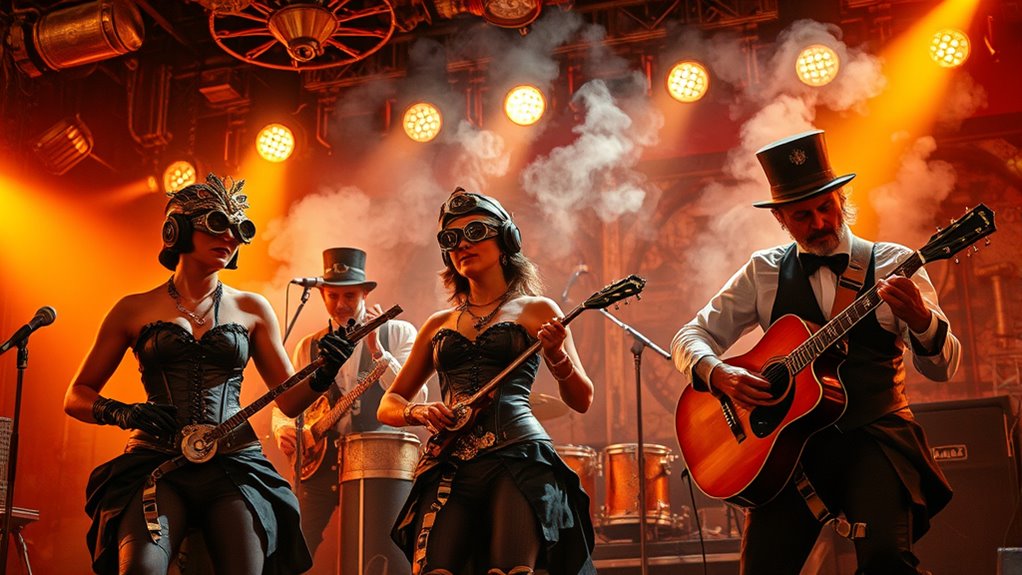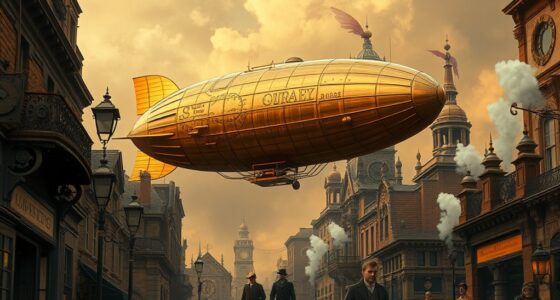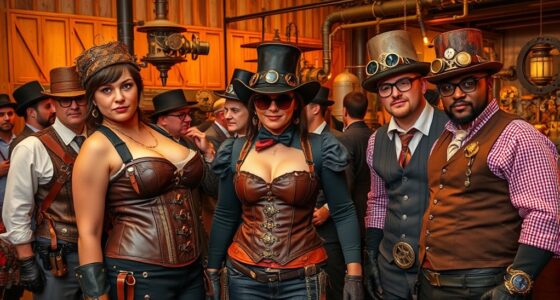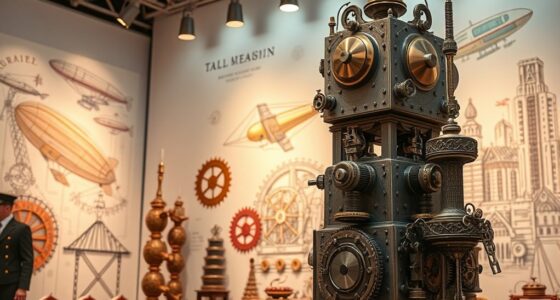The sound of steampunk blends Victorian-era instruments like brass horns and vintage pianos with futuristic electronic elements to create a unique, immersive atmosphere. Performances often feature elaborate costumes, theatrical storytelling, and ornate stage designs, making each show feel like stepping into a fantasy world of invention and tradition. Audience participation and craftsmanship play key roles, transforming concerts into holistic artistic experiences. Keep exploring, and you’ll uncover how this genre continues to redefine musical innovation and cultural storytelling.
Key Takeaways
- Steampunk music blends Victorian-era instruments with futuristic electronic sounds to create a nostalgic yet innovative auditory experience.
- Performances often incorporate elaborate costumes, theatrical storytelling, and immersive stage design to enhance the genre’s visual appeal.
- Musical instrumentation includes vintage pianos, brass horns, mechanical devices, and experimental electronic elements for layered soundscapes.
- Audience engagement is encouraged through themed accessories and activities, fostering deeper immersion in the steampunk universe.
- Artistic performances emphasize craftsmanship, storytelling, and spectacle, reflecting the genre’s core values of inventive reinvention and cultural fusion.

Steampunk music and performance art blend Victorian-era aesthetics with futuristic innovation, creating a unique genre that immerses audiences in a world where steam-powered technology and fantasy collide. When you experience steampunk, you’re transported to an alternative universe that combines the elegance of the 19th century with inventive, often surreal, modern twists. One defining feature of this genre is its use of Victorian instrumentation, which includes period-appropriate instruments like vintage pianos, brass horns, and mechanical devices repurposed to produce music. These sounds evoke a sense of nostalgia while simultaneously pushing boundaries with experimental electronic elements and unconventional sound design. As a result, the music feels both familiar and otherworldly, capturing the spirit of invention and reinvention that characterizes steampunk culture.
In live settings, steampunk artists often perform in alternative live shows that break away from traditional concert formats. These events aren’t just about the music; they’re immersive experiences that combine elaborate costumes, theatrical storytelling, and visual art to create a holistic spectacle. When you attend one of these shows, you’ll notice that performers often incorporate Victorian-inspired fashion—corsets, waistcoats, top hats, goggles—and blend it with futuristic accessories like LED-lit gears or steampunk weaponry. The stage design complements this aesthetic, featuring ornate machinery, clockwork elements, and Victorian decor, transforming the venue into a steampunk wonderland. These performances emphasize the artistry of their presentation, making every show a narrative adventure rather than just a concert.
Alternative live shows in the steampunk genre also encourage audience participation and interaction. You might find yourself donning a gear-adorned accessory or engaging in themed activities that deepen your immersion into this world. The blend of Victorian instrumentation with modern performance techniques creates a dynamic atmosphere, where live musicians may incorporate mechanical sounds or vintage synthesizers alongside traditional instruments. The result is a layered, textured soundscape that’s as innovative as it is nostalgic. These performances celebrate creativity and craftsmanship, highlighting the genre’s core values of ingenuity and imagination. Additionally, musical innovation plays a crucial role in shaping how artists push the boundaries of traditional sound to craft immersive auditory experiences.
Frequently Asked Questions
How Has Steampunk Music Evolved Over the Past Decade?
Over the past decade, you’ve seen steampunk music evolve through fusion genres that blend traditional Victorian sounds with modern electronic and digital influences. This blending creates a unique soundscape that’s both nostalgic and innovative. You might notice more artists experimenting with steampunk aesthetics in their performances, using digital tools to enhance their music and storytelling. The genre continues to grow, reflecting a dynamic mix of old-world charm and contemporary technology.
What Are Some Iconic Instruments Used in Steampunk Performances?
You’re immersed in a world where Victorian instrumentation and mechanical soundscapes collide, creating an awe-inspiring auditory experience. Iconic instruments like vintage gramophones, steam-powered calliopes, and theremins define steampunk performances, transforming ordinary sound into fantastical symphonies. These tools amplify the genre’s retro-futuristic aesthetic, making each performance feel like stepping into a steampunk universe where technology and tradition forge unforgettable, otherworldly melodies that captivate every listener’s imagination.
How Do Steampunk Musicians Incorporate Victorian Aesthetics Into Their Acts?
You incorporate Victorian fashion and Steampunk symbolism into your acts by dressing in elaborate costumes featuring corsets, waistcoats, and top hats. You use accessories like gears, cogs, and retro-futuristic gadgets to highlight the genre’s aesthetic. Your performances often include Victorian-inspired props and themes, blending historical styles with imaginative elements, creating an immersive experience that celebrates the elegance and innovation of Steampunk culture.
Are There Any Notable Steampunk Music Festivals Worldwide?
Imagine stepping into a world where Victorian fashion meets futuristic innovation—there are several notable steampunk music festivals worldwide. You’ll find events like the Steampunk World’s Fair in New Jersey and the Asylum Steampunk Festival in the UK, where steampunk literature and fashion blend with lively performances. These festivals celebrate creativity, combining Victorian aesthetics with modern rhythms, offering a mesmerizing experience for all fans of the genre.
How Does Steampunk Performance Art Differ From Other Alternative Genres?
You notice that steampunk performance art stands out because it blends Victorian theatricality with a strong DIY ethos. Unlike other alternative genres, it emphasizes elaborate costumes, storytelling, and immersive experiences rooted in 19th-century aesthetics. You’ll see performers often creating their own props and costumes, fostering a sense of community and creativity. This fusion of historical influence and hands-on craftsmanship makes steampunk performances uniquely engaging and distinctly different from other modern alternative arts.
Conclusion
As you step into the world of steampunk music and performance art, you become part of a living clockwork, where every gear and tune intertwines to create a mesmerizing symphony of innovation and nostalgia. This genre invites you to dance along its intricate mechanisms, blending the past and future into a enthralling spectacle. Embrace the rhythm, and let the gears of creativity turn your imagination into a steampunk masterpiece.









